By Emily Stone
Naturalist/Education Director, Cable Natural History Museum
“Can’t you smell that?” asked Cade from the bow of the canoe. A warm breeze tickled the back of my neck and blew any odors away from me. He’d brought up a small piece of an aquatic plant with a similar structure to the bladderwort leaves I’ve examined recently. The central, green stem bore whorls of thin leaves.
As Cade placed the curiosity on the blade of my canoe paddle, the breeze swirled, and I caught more than a whiff of sulfur. “It’s chara!” he declared.
Also known as muskgrass or skunkweed due to its strong odor, chara is a type of algae that grows in clean, hard water with a high pH and lots of minerals. Those conditions are rare in the igneous bedrock and glacial sands so prevalent around Cable. Acidic bogs or lakes tinted brown with tannic acid are much more common here. But my bedrock maps show the possibility of nearby dolomite—a calcium-rich rock similar to limestone. We knew we were exploring a special place.
The last time I saw chara was in another special place: Alaska. When I tagged along with four young geologists taking sediment cores from the bottom of Kelly Lake on the Kenai Peninsula, we found stripes of pale “marl” deposits along with the gray-brown silt.

On the scientists’ sampling raft, I pulled out a small bottle of 10 percent hydrochloric acid leftover from Professor Tom Fitz’s rocks and minerals course in college, and let a few drops fall onto a band of marl. Bubbles erupted. “Mad fizzer!” I exclaimed. The acid was reacting with a base—the same way that vinegar and baking soda make mini volcanoes. The base was calcium carbonate from the long-dead bodies of chara. Read more of this Alaskan adventure in my blog post titled “Masters of Mud” (www.bit.ly/3NrLKvC).
Stonewort is another name for chara, since mineral deposits form on its stems as a byproduct of photosynthesis. Not unlike the acid I dropped onto the marl, the chara itself pumps hydrogen ions (which make acidity) into the water, where they react with calcium bicarbonate and release carbon dioxide—which the plant uses to photosynthesize.
A further series of reactions in the calcium-rich water (this section is intentionally vague; please note that I have not taken chemistry since high school) results in the deposition of calcium carbonate on the chara’s surface—making it feel rough and grainy. If left to dry or decompose, chara turns ashy and gray.
Sometimes calcium phosphate forms as part of the processes, which locks up phosphorous that might otherwise fuel blooms of harmful algae and phytoplankton. Those would compete with the chara for sunlight. Humans also generally prefer the very clear water where chara grows to the somewhat soupy water that often results from phosphorus pollution.
Another side benefit of having chara in your lake is that it seems to interfere with the development of mosquito larvae. In a 1928 issue of the Journal of Tropical Medicine, R. Matheson and E.H. Hinman published an experiment they conducted with mosquitoes and chara in aquariums. They found that adding powdered chara to the aquariums killed a significant percent of mosquito larvae, and they hypothesized that the high pH of chara has something to do with it.
Curiously, in 1929 the same guys found that dead or dying chara didn’t impact the development of mosquito larvae in their aquariums. They did find that vigorously growing chara resulted in the death of all the introduced mosquito larvae. Matheson and Hinman hypothesized that high oxygen or low nutrients might be the issue. Cade and I wonder if those hydrogen ions or the stinky hydrogen sulfide might also be at work.
Looking back at my photos of the chara, one other oddity stood out. Some of the whorled stems had small, red-orange appendages. Wikipedia tells me that these are antheridia—sort of like anthers in plants—the male reproductive structures. A fertilized egg forms an oospore with a hard, mineral case. With spiraling ridges on an oval shape, the oospore looks like a mini foam football. These fossilize easily and provide a record of past habitats and climate for anyone who wants to bring them to the surface in a sediment core.

As Cade and I circumnavigated the pond, our paddle strokes stirred up more of the skunkgrass odor. My underwater camera revealed that diatoms—a smaller type of algae—grew in a golden film over all of chara’s surfaces. Thick beds of chara rose high enough to break the surface at one end, and there we found dozens of snails, a newt, and other critters hiding out in the mass of stems.
Last week I asked what new mystery I would discover the next time I went exploring in a fen. This week, we followed our noses and found chara. Next week…?
Emily’s award-winning second book, Natural Connections: Dreaming of an Elfin Skimmer, is now available to purchase at www.cablemuseum.org/books and at your local independent bookstore, too.
For more than 50 years, the Cable Natural History Museum has served to connect you to the Northwoods. The Museum is now open with our exciting Growing Up WILD exhibit. Follow us on Facebook, Instagram, YouTube, and cablemuseum.org to see what we are up to.
